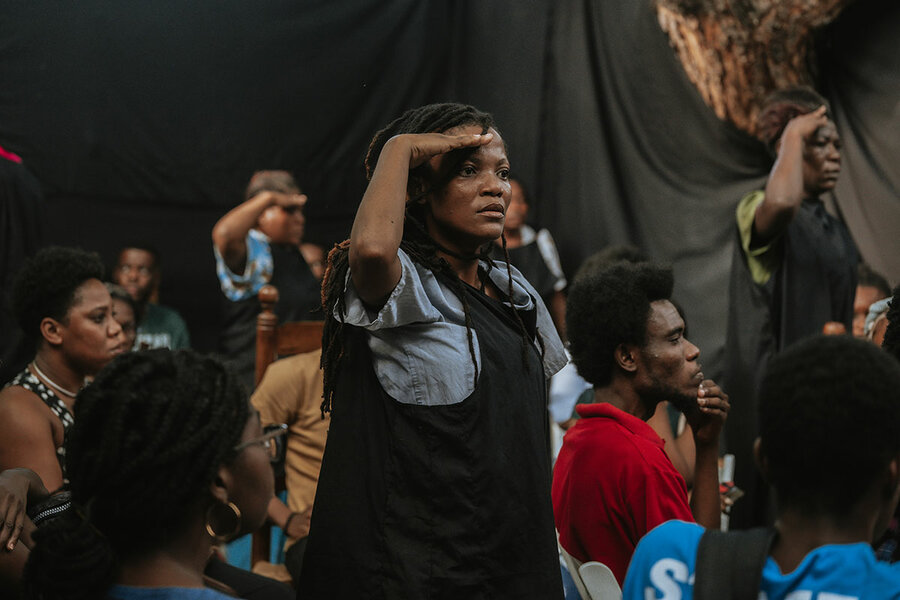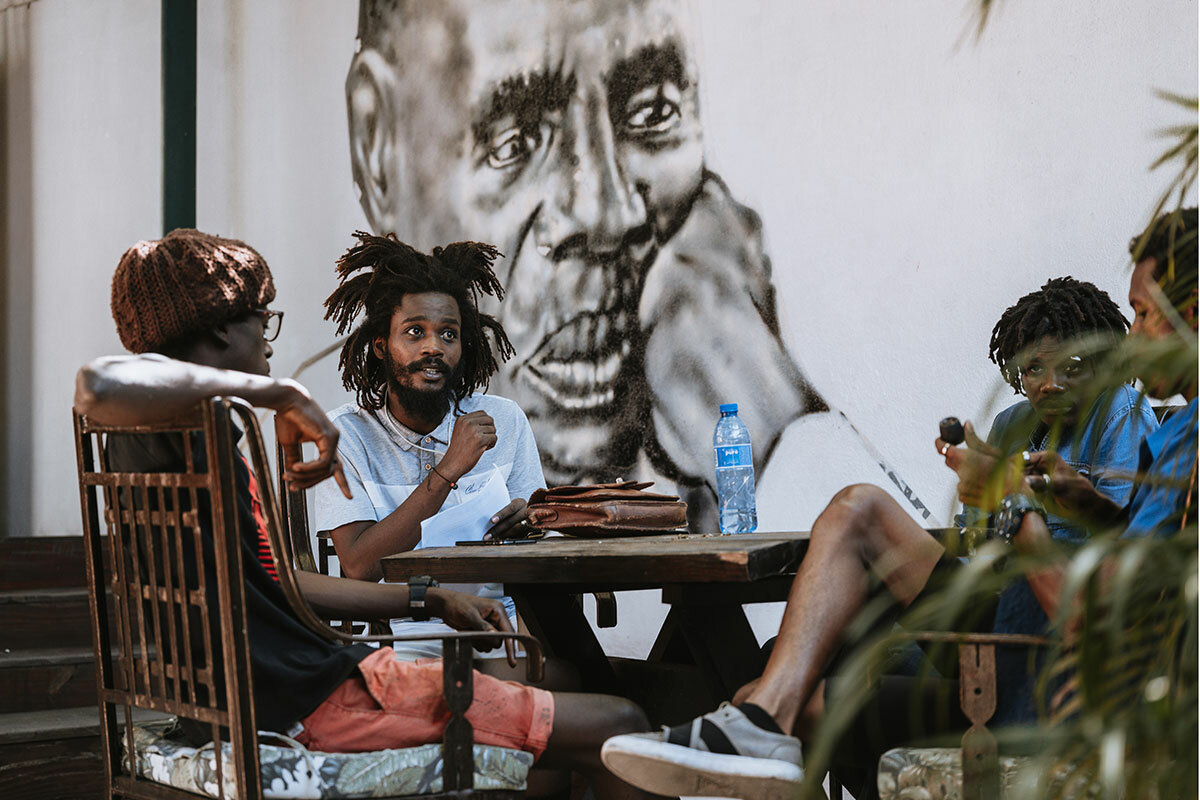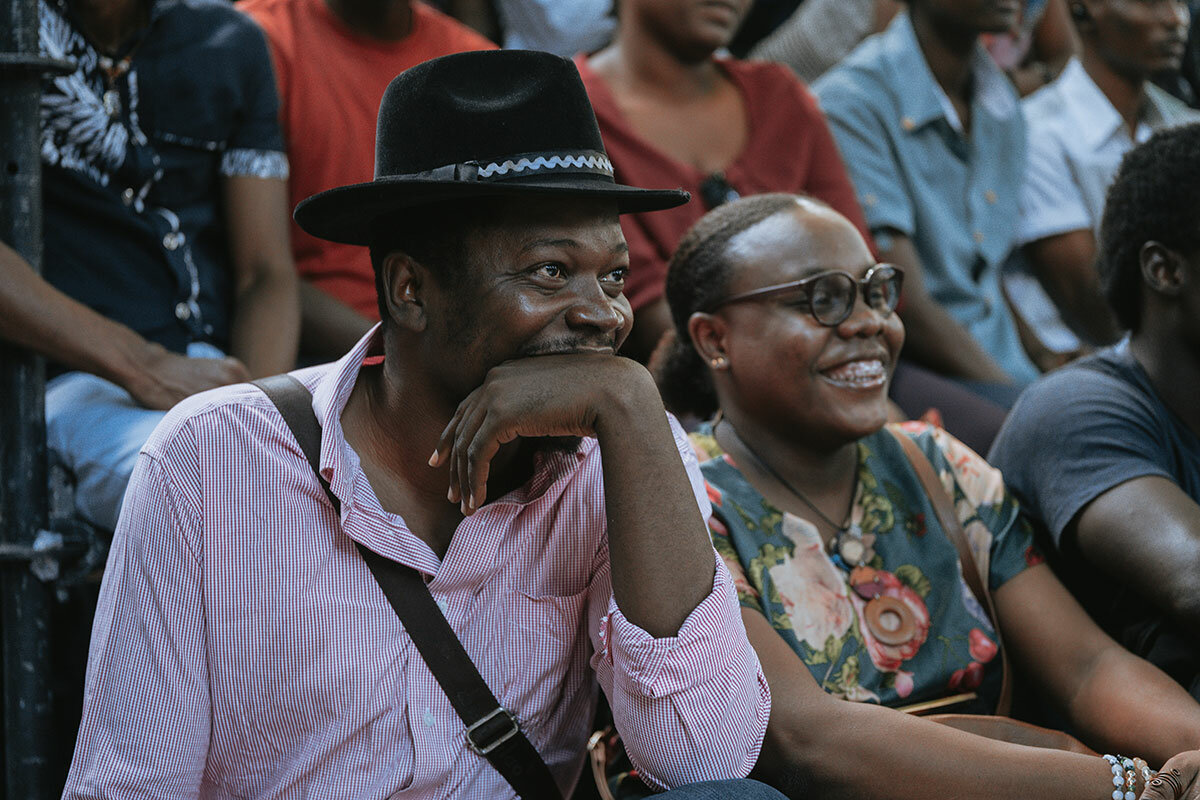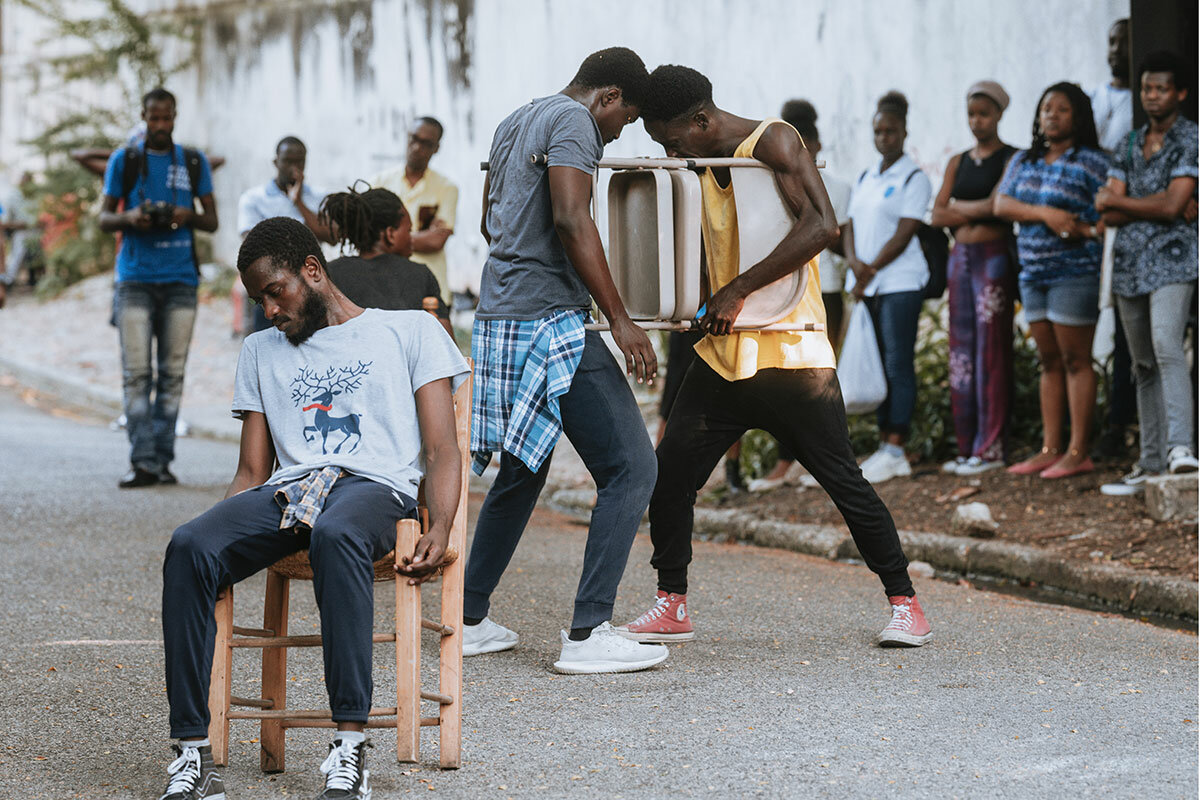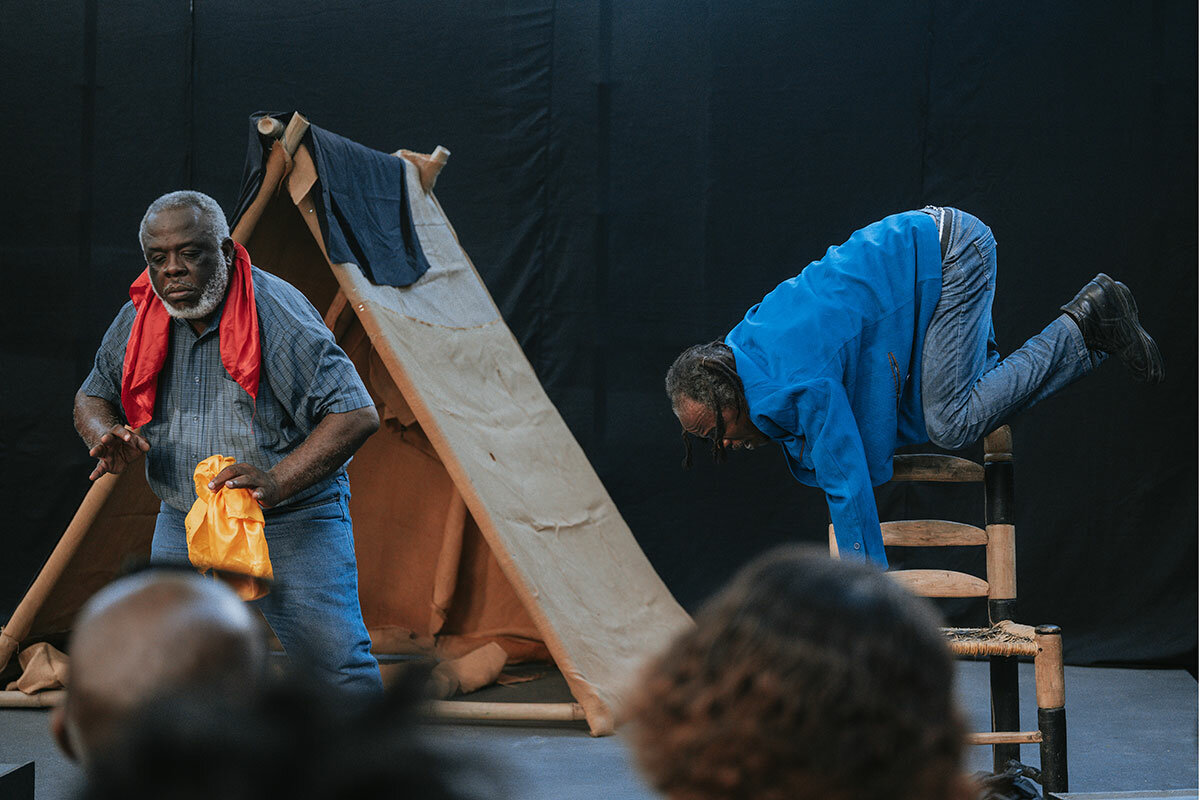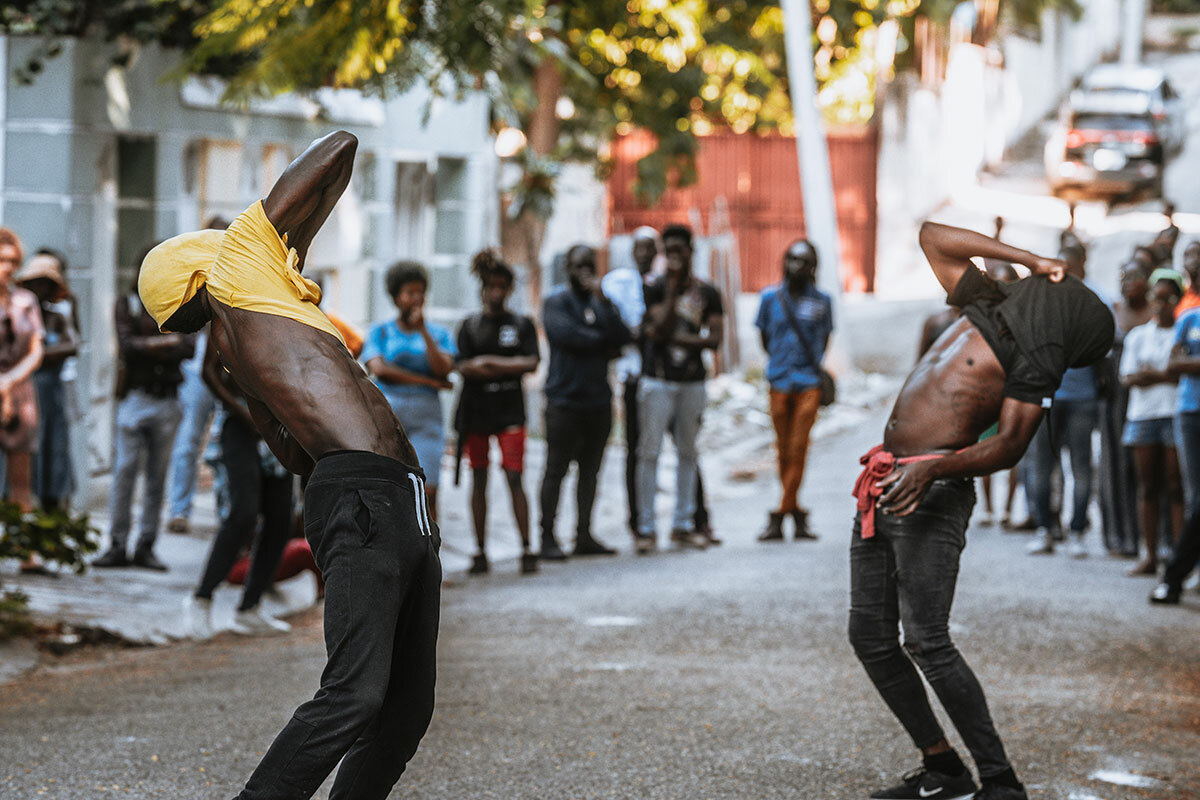Culture as resistance? Haitians defy gangs by embracing theater.
Loading...
| PORT-AU-PRINCE, HAITI
On a sunny afternoon, some 60 people gather in the small courtyard of Yanvalou Café, the unofficial home of Haiti’s theater scene. It’s the opening of the 19th annual Quatre Chemins (Four Paths) theater festival, but the fact that there’s a full house was never a given.
For the past three years, Port-au-Prince, Haiti’s capital, has been overrun by criminal gangs. They’ve increasingly terrorized citizens, carrying out kidnappings, sexual assaults, and armed robberies, and blocking freedom of movement since the assassination of President Jovenel Moïse in July 2021. Many citizens have fled their homes in recent months, seeking safety elsewhere – in some cases camping out in public parks because their neighborhoods have become so dangerous.
“This city is scary these days,” says Évens Dossous, an educator who came to see the reading of “Port-au-Prince et sa Douce Nuit (Port-au-Prince and Its Sweet Night),” a new play by award-winning Haitian playwright Gaëlle Bien-Aimé. Before leaving home this afternoon, “I asked myself, ‘Is it really worth traveling? Will I be kidnapped?’”
Why We Wrote This
A story focused onPort-au-Prince is overrun by criminal gangs blocking transit and terrorizing the population. And yet, many Haitians are risking their lives to attend the theater, something they see as an act of resistance.
Art, and specifically theater, have a rich history of political resistance in Haiti. Although the unprecedented climate of insecurity has more to do with a vacuum of leadership – there have been no elections since 2016 – than with the overt oppression and censorship that citizens faced under dictatorships in the past, the crowd at Yanvalou today is a reminder that theater remains an act of defiance.
“You know, life can’t just be about insecurity,” says Mr. Dossous.
“A living art” amid violence
Colorful murals of well-known artists and thinkers cover the cement walls at Yanvalou, including singer Nina Simone, Haitian dancer Viviane Gauthier, and national anthropologist Jean Price-Mars. The audience at the opening in November makes its way from the courtyard into the restaurant, where chairs are set up facing two lecterns.
The reading focuses on the lives of two young people, madly in love, in a home in Pacot, a wooded, formerly upscale neighborhood in the heart of Port-au-Prince. It underscores many real-life challenges, like the fragile state of the capital and the difficulty of leaving the house to get food, travel, or go to school or work. But it also dives into bigger questions, such as how to love – oneself and others – when a city is collapsing around you.
“Theater helps me ask questions about my life,” says Ms. Bien-Aimé, the playwright, who was the second Haitian in a row to win the prestigious RFI Theatre prize, awarded to emerging Francophone artists. Theater “is a living art,” she says.
Since the assassination of President Moïse, armed gangs have taken control of some 70% of the capital. From blockading a fuel terminal last September that immobilized transportation and industry nationally to controlling key neighborhoods, gangs here have generated disorder and hunger, and heightened the political crisis. Some 20,000 Haitians are facing starvation, according to the United Nations, the vast majority of whom are located in the capital.
The insecurity, which includes using sexual violence as a weapon, has led to widespread displacement. Kidnappings increased by nearly 45% in Port-au-Prince in the second quarter of 2022, according to the National Network for the Defense of Human Rights, a Haitian nongovernmental organization. Many believe the gangs are protected by police, politicians, and business elite.
“The state has agreed to retreat so that armed groups can control the society,” says Sabine Lamour, a Haitian sociologist at the State University of Haiti, citing research by Haiti’s leading human rights organization, the National Human Rights Defense Network.
By early October last year, the Haitian government, led by acting President Ariel Henry, officially requested foreign military intervention to tackle security challenges. Despite the chaos here, many reject the idea. Human rights abuses and the introduction of cholera by foreigners working with the U.N.’s stabilization mission in 2010 have left a lasting, negative impression of international meddling. The United States this week charged four men with involvement in Mr. Moïse’s assassination, a reflection of Haiti’s troubled justice system.
Micaëlle Charles, the actor reading the lead role of Zily in today’s play, says a lot has changed in Haitian theater over the past three years. She and the entire team putting on today’s show take security precautions she never considered before, such as sleeping over at the rehearsal space. “This helps me to hold on, despite the problems in the country or any other problems life might throw my way,” she says of her passion for the craft.
“It is unfortunate that artists and cultural organizers have to think about security this much,” says Éliezer Guérismé, artistic director of En Lisant, another performing arts festival. Over the past few years, festivals have started functioning under new, self-imposed rules, such as only holding events during the day, so that spectators can return home while the sun is still up. “This means we can’t do [stage] lighting, but we gain in security, and this allows our public to trust us more,” says Mr. Guérismé.
Culture as resistance?
Using theater for social or political commentary isn’t unique to Haiti, but it has a long tradition here. Theater is “a weapon of mass awareness that gives the spectator the means to free themselves,” wrote Félix Morisseau-Leroy in 1955. He was one of the nation’s first writers to create plays in Haitian Creole. Under the Duvalier regime, a father-son dictatorship that ruled Haiti for three decades starting in 1957, Mr. Morisseau-Leroy and others were targeted and exiled for their social commentary and what was perceived as anti-government messages in plays and literature.
The Duvalier reign was characterized by violence and the suppression of free expression. One of Mr. Morisseau-Leroy’s most prominent works was his Haitian Creole translation of the Greek tragedy “Antigone,” a play about a tyrant who meets his demise because of his excessive pride. It was an act of resistance for its message – and its use of the language of the masses.
“To become aware of what one is, of one’s situation in the world, of one’s role in society, is to get rid of the illusions that power of all kinds imposes on us,” Joubert Satyre, an expert on Haitian theater, told The Christian Science Monitor late last year.
Even today, theater in Haiti plays an important role in social and political struggles, he said.
“It is this liberating and critical side of the theater that has made it, and that still makes it, suspect in the eyes of autocrats.”
Not that the government is paying much attention to the arts in recent years, says Ms. Bien-Aimé. She’s firmly engaged in a “theater of protest,” she says, but isn’t sure her artwork frightens the government as much as her outright activism. In the summer of 2018, a massive anti-corruption movement emerged seeking accountability for the government’s squandering of an estimated $3 billion. Haitians filled the streets for months, but the assassination of President Moïse and the rapid rise in gang violence brought this key period of public dissent to a halt.
“Today, the state doesn’t even go to the theater,” she says.
But plenty of Haitians do, including other artists and students hoping to make art their lifework. Despite the enthusiasm at today’s show, violence and crime have contributed to the dwindling of live theater. To be sure, a government in chaos is part of the problem: Investment in all sectors from infrastructure to education is insufficient. That, unfortunately, translates to theaters shuttering and Haitians previously interested in pursuing the craft choosing other careers, says Mr. Guérismé.
“The question of funding has always been a thorny problem but is now exacerbated by political and social instability,” he says. His team is trying to come up with creative plans to self-finance its festival.
A lot depends on Haitians’ historic love for theater weathering this challenging moment.
Stephanie Jean, an NGO worker in her late 30s, rode 20 minutes on the back of a motorcycle to attend the Quatre Chemins festival. It was her first real outing since a close relative was kidnapped in August. She was in knots over whether to attend.
“Culture is one of the strongest ways we resist,” she says. “In such a politically and economically fraught context, art is how we remind ourselves and the world that we are alive,” Ms. Jean says.
“I come here to feel alive.”
This story was produced with support from the Round Earth Media program of the International Women’s Media Foundation in partnership with Woy Magazine. Melodie Cerin contributed reporting from Port-au-Prince; Nathalie Cerin translated French to English.




